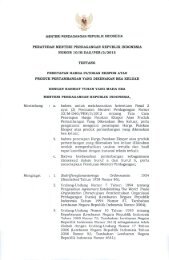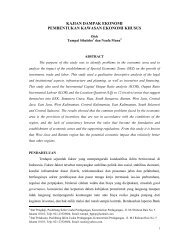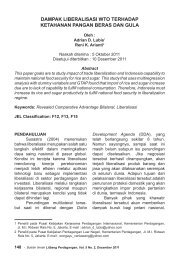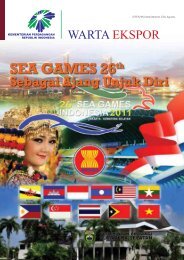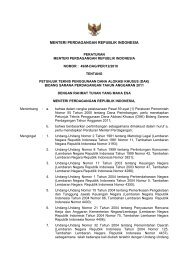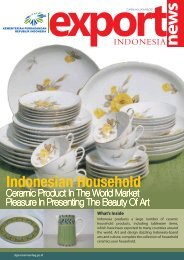Indonesia
Indonesia
Indonesia
Create successful ePaper yourself
Turn your PDF publications into a flip-book with our unique Google optimized e-Paper software.
having access to unlimited information. They could help assist craftsmen in improving<br />
their products in order to fulfill demands from contemporary market and the whole<br />
system around it (i.e. distribution, promotion, contract, management, etc.). This,<br />
however, will work only when the industrial designers are capable of recognizing local<br />
potentials, making correct analysis towards the products and applying technology<br />
that is appropriate for the local conditions.<br />
Prior to the afore mentioned conditions, formal education in industrial design is<br />
pioneered by teaching staffs of the Faculty of Arts and Design ITB who originally<br />
learned to be drawing/painting teachers. They were sent abroad, mostly to the United<br />
States, to learn about industrial design and to apply the knowledge in <strong>Indonesia</strong>.<br />
However, the basic of the knowledge mostly come from Western (American and<br />
European) cultures, along with their ideologies, which are being taught to industrial<br />
design students already for about thirty years. As a consequence, up to recent times,<br />
graduates of industrial design are lack of knowledge concerning <strong>Indonesia</strong>’s own<br />
material resources, artifacts and traditional production systems. This point is what<br />
makes it difficult for designers to start intervening the home industries such as the<br />
ones mentioned beforehand. Realizing the disadvantages, current industrial design<br />
students are given materials about local contents as well, which has broadened the<br />
viewpoints of new graduates.<br />
INDONESIAN DESIGN PARADIGM<br />
Design development in many parts of the world has shown significant progress,<br />
especially due to the innovation of advanced technology and material inventions,<br />
along with development of design concepts and philosophies. As a consequence,<br />
designs that were created in the 20th century, which used to retain ornamental<br />
appearances, gradually appeared in simpler forms and in more efficient, practical,<br />
durable and affordable conditions. The 20th century is also known as an era of<br />
competition, therefore manufacture industries started to recognize the role of design<br />
in capturing and creating (new) markets.<br />
Design products have also embedded in our daily lives and have become our routine<br />
needs, such as houses, cars, television sets, chairs, wristwatch, etc. Questions concerning<br />
the competitive capability of <strong>Indonesia</strong>n design raise, especially considering the fact<br />
that <strong>Indonesia</strong> has an abundance of human, natural and cultural resources, and a<br />
strategic geo-political position. In this context, design is not merely applied to the<br />
quantitative value of a particular product, but as a media that represents the level of<br />
civilization of its country of origin. Considering that matter, design needs to have the<br />
following basis, which should work as a compact system and a total process:<br />
•<br />
•<br />
•<br />
•<br />
National awareness towards design<br />
Natural and human resources<br />
Technology and industry<br />
Strategy and policy from a national design council<br />
CREATIVE & INNOVATION INDONESIA<br />
15<br />
produk rev akhir.indd 15<br />
4/7/2009 6:11:15 PM



